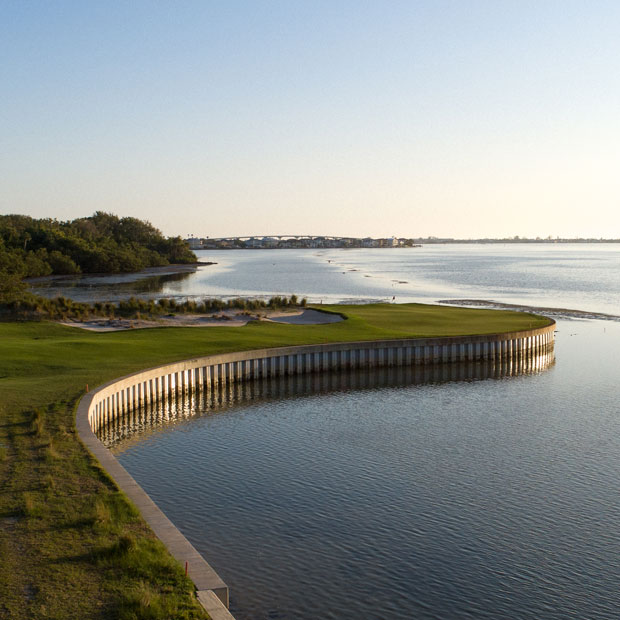Variety Steals the Show at Wilshire
A look at the Norman MacBeth-designed Wilshire CC, set in the heart of Los Angeles


In Los Angeles, glitz and glamour tend to outshine the humble virtues of creativity and craftsmanship. While actors and singers get all the attention, writers and producers are often overlooked, even though they deserve much of the credit for the end product, whether it’s a song, a movie, or a golf course.
When discussing Wilshire Country Club, the host of this week’s Hugel-Air Premia LA Open on the LPGA Tour, the media tends to focus on its glamorous history, long list of famous members, and downtown location. According to club lore, many legends have walked Wilshire’s grounds. On the 9th hole, Ben Hogan is rumored to have asked which “E” to aim at on the El Royale building. On the 8th, longtime member Howard Hughes reportedly had movie star Jean Harlow stand on the balcony of his nearby house to distract his competitors. These tales have cast a long shadow over Wilshire Country Club’s real star: its radiant course, designed in 1920 by architect Norman MacBeth.
Located in the heart of LA’s Larchmont Village, Wilshire sits on 100 acres of relatively flat land. Its best natural feature is a barranca that winds through the property. Today, Beverly Boulevard splits the 6500-yard course’s front and back nines. Over the past decade, architect Kyle Phillips has revitalized the course, bringing back MacBeth’s rugged, artistic bunkering and removing trees to open up long views across the course.
{{content-block-wilshire-country-club-review-001}}
The new look has brought to light the brilliance of Wilshire’s original design. A lesser-known architect of the Golden Age, Norman MacBeth took a fairly unpromising piece of land and transformed it into a golf course of supreme variety.
A Quartet of Unique Par 3s
“How deadly dull are two or three holes of the same character when they follow each other! A drive and pitch followed by another drive and pitch is a good deal like serving a watery pudding after a watery soup!” -Robert Hunter
Architects can infuse variety into a golf course in many ways: hole length, playing direction, bunkering, slope, undulation, and green shaping, to name a few. On a small site with little topographical interest, true variety becomes difficult to achieve. At Wilshire, however, MacBeth was up to the challenge. His par 3s, for instance, are exemplars of variety. Not only are they distinct from one another, but they play differently from day to day. The distinctiveness and versatility of these holes are due to their unique green complexes.
Wilshire’s first par 3 is the 4th, which crosses the barranca to a wild green. Before Kyle Phillips started his work, the front portion of this two-tiered expanse was fairway, but he restored it to putting surface. The result is a 65-yard green that allows the hole to play from 135 to 200 yards.
From day to day, the hole calls for different kinds of iron shots. A severe ridge bisects the green into front and back sections. The shorter shot has to contend with the barranca, which guards the front and left sides of the green. To the right is a severe contour that repels balls into a collection area and makes for challenging up-and-downs. The longer shot to the small, heavily bunkered back half of the green requires a pure mid- to long iron. Coming up even slightly short leaves a difficult lag putt over the ridge.
{{content-block-wilshire-country-club-review-002}}
Like the 4th, the 141-yard 7th has a massive putting surface. Whereas the 4th is long, however, the 7th is wide: the green has distinct left and right portions split by a deep front bunker. A front left pin can play under 100 yards and back right one as long as 150.
The left half of the green rewards distance control. It is a mere twenty yards deep and menaced by barranca short, a bunker right, and another bunker long. In contrast, the right portion of the green is long and narrow. The most dangerous pin is at the back. If you go at this pin and get over-aggressive or misjudge the wind, you might even go out of bounds.
{{content-block-wilshire-country-club-review-003}}
The back nine opens with the 10th, a par 3 of 156 yards. This hole requires a lofted approach to a narrow, bean-shaped green that angles from left to right. The green pinches in the middle to a tiny nine yards wide but measures 55 yards from the front right to back left.
For a chance at birdie, the player needs impeccable accuracy and distance control. The angle of the green penalizes common misses for right handers who have wedges or short irons in their hands. Bunkers catch shots that fall short and right, whereas contouring and another bunker hurt shots that travel long and left.
Note: The 10th plays as the 18th for the Hugel-Air Premia LA Open on the LPGA Tour.
{{content-block-wilshire-country-club-review-004}}
The last of Wilshire’s stellar par 3s is the 13th, which has two greens. The more frequently used green—and the one in play in the ladies’ LA Open—is on the right. This target is elevated and sits about 185 yards from the back tees. The green angles slightly from left to right, favoring a well-struck fade. The primary defenses are bunkers front right and back left as well as a false front that cuts diagonally from right to left.
Tiny, severely sloped, and fronted by a treacherous bunker, the second green feels like an ode to the Eden hole at the Old Course. Unlike the Eden, however, the alternate 13th a mere 85 yards. Still, it is exacting and demands a perfect wedge.
Note: The 13th plays as the 12th for the ladies’ LA Open.
{{content-block-wilshire-country-club-review-005}}
In discussions of Los Angeles golf course architecture, Wilshire often gets overlooked. Bel-Air CC, Riviera CC, and Los Angeles CC all have stunning properties to go along with their architecture. In each case, George Thomas showed his creativity and routing skill by using LA’s many canyons. At Wilshire, Norman MacBeth accomplished something different but impressive in its own right. Presented with a small and unpromising site, he created 18 unique holes that the golfer has no trouble remembering after one round. This achievement, which has played a big part in Wilshire CC’s history for so long, deserves its turn in the spotlight.
For golf fans who want to bring home a piece of this course, we offer a collection of Wilshire photography prints shot by the Fried Egg Golf team available in our Pro Shop.
Sign Up for The Fried Egg Newsletter
The Fried Egg Newsletter is the best way to stay up to date on all things golf. Delivered every Monday, Wednesday, and Friday for free!
Leave a comment or start a discussion
Engage in our content with thousands of other Fried Egg Golf Club Members
Engage in our content with thousands of other Fried Egg Golf Members
Get full access to exclusive benefits from Fried Egg Golf
- Member-only content
- Community discussions forums
- Member-only experiences and early access to events












Leave a comment or start a discussion
Lorem ipsum dolor sit amet, consectetur adipiscing elit. Suspendisse varius enim in eros elementum tristique. Duis cursus, mi quis viverra ornare, eros dolor interdum nulla, ut commodo diam libero vitae erat. Aenean faucibus nibh et justo cursus id rutrum lorem imperdiet. Nunc ut sem vitae risus tristique posuere. uis cursus, mi quis viverra ornare, eros dolor interdum nulla, ut commodo diam libero vitae erat. Aenean faucibus nibh et justo cursus id rutrum lorem imperdiet. Nunc ut sem vitae risus tristique posuere.